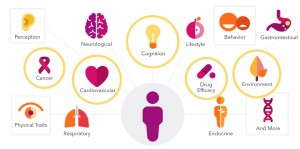Researchers know that certain genes, or more accurately regions in our genes, are  multitaskers, influencing a wide variety of traits and conditions that range from such things as the size of our noses to our susceptibility to childhood ear infections to our risk for Parkinson’s disease.
multitaskers, influencing a wide variety of traits and conditions that range from such things as the size of our noses to our susceptibility to childhood ear infections to our risk for Parkinson’s disease.
A new study led by researchers at the New York Genome Center and 23andMe analyzed 42 different traits and identified more than 300 locations in the genome that influence multiple traits and conditions. The study, published in Nature Genetics, was supported through a grant from the National Institutes of Health.
It’s not news that a single genetic variant may influence multiple traits and conditions. There’s even a name for this in genetics: pleiotropy. But this research took that one step further going beyond the mere correlation and developing a method to identify the biological relationships between traits to show causal connections.
“While genomic studies have been successful in identifying genetic variants that influence disease risk, it’s important to understand the impact of genetic variants across many diseases,” said Joseph Pickrell, PhD, the lead author of the study and an assistant investigator at New York Genome Institute.
Pickerll is also an Adjunct Assistant Professor in the Department of Biological Sciences at Columbia University.
He said genetic variants may be influence many different conditions in different ways.
“For example, if a genetic variant decreases risk of schizophrenia but increases risk of Parkinson’s disease, drugs that target this gene may have unintended consequences,” Pickrell said.
Excluding so-called “trivial” correlations, the researchers identified several different clusters, some of which showed causal relationships. This causal relationship might be direct, so for example a single genetic variant might influence many different traits or conditions, or a variant might influence one trait or condition and that in turn leads to another trait or condition.
Researchers in this study found that variants known to influence puberty also influence height, male pattern baldness and BMI, which are all related to hormonal regulation. Another cluster was found around metabolic conditions such as coronary artery disease, red blood cell traits and lipid levels. And researchers also noted clustering around immune response with conditions like asthma, allergies, Crohn’s disease, rheumatoid arthritis and infectious diseases like childhood ear infections and tonsillitis clustering together.
The researchers say their study validates the use of genome wide association studies to find variants that influence many different traits. In turn identifying them may also help to highlight true causal relationships by bringing into sharp relief the biology behind certain conditions. Although the researchers say they have only identified a modest number of variants that causally influence multiple traits and conditions, they suggest that a larger study would uncover many more.
Finally this study also highlights the value of the mix of data 23andMe customers share for research, which includes not just genotypic data from detailed phenotypic information.
This allowed 23andMe to contribute to this study by including information from more than 300,000 customers who consented to research.
This is valuable information for researchers who can tap into a wide range of phenotypes as varied as allergies and asthma or the timing of puberty or whether they have chin dimples or had a lot of ear infections as a child. It’s this kind of rich data that can lead to unexpected insights that 23andMe is uniquely able provide scientists.
“This study illustrates the value of collecting not just genotypic data but a wide variety of phenotypic data, something that 23andMe is uniquely able to do,” said co-author David Hinds, PhD, principal scientist, statistical genetics at 23andMe. “The ability to study this type of rich phenotypic and genotypic data at scale makes it possible to uncover unexpected insights.”
The study appears in the journal Nature Genetics.